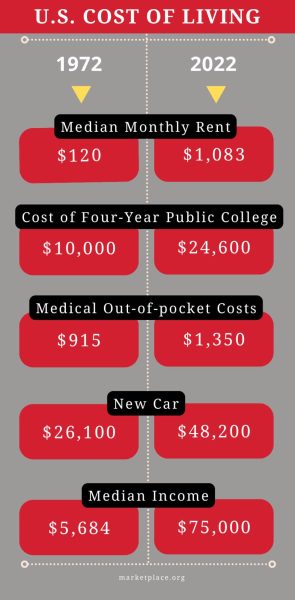
Five-dollar coffee, $6-a-gallon gas and $300-a-month groceries have become the norm for many Angelenos over the years. While the price of these necessities of life continues to grow, people’s wages only slightly increase, forcing many residents to work multiple jobs to afford living expenses.
The cost of living in Los Angeles is 49.1% higher than the national average, according to CNBC, which factored in housing, utilities, groceries, transportation, health care and miscellaneous goods or services. It found that only five cities are more expensive to live in than LA, two of which are in California. Orange County is 50.3% above the national average, and San Francisco is 69.9% above it.
The cost of living in LA rose 3.2% in 2023, mainly because of the high cost of food, housing and transportation. Back in October 2020, it dipped below 1% before skyrocketing 8.6% in July 2022, according to the Bureau of Labor Statistics.
In December, LA tied Hong Kong for the fourth-most expensive city in the world to live in, according to Spectrum News.
The average rent for a one-bedroom apartment here is $2,296 per month, which equates to $27,552 per year, just over half the median income in LA.
One of the main reasons housing costs have increased is the shortage of housing itself. According to Scott Weiner, a California Democrat on the Senate Housing Committee, California’s population grew from 15 to 40 million over the last few decades, while housing production dropped by two-thirds.
“We basically stopped building housing about 50 years ago, and while there have been periods where we built more housing, it has generally been declining,” Weiner told KTLA5.
The cost of living in Los Angeles has increased, but wages have not risen to accommodate the growth.
According to Financial Planner LA, the median income in LA is just under $50,000 per year. That is $25,000 less than what it takes to be able to afford more than just the necessities. The minimum wage in LA County is $15.50 per hour as of July 1, 2023. The LA Almanac reports that rent for a one-bedroom apartment in LA County would take up two-thirds of the income of a person making minimum wage.
In 2014, the minimum wage was only $9 per hour. It steadily increased since, reaching its current amount of $15.50 per hour.
The November 2024 ballot will feature an initiative to increase the minimum wage across California to $18 per hour. If the initiative passes, the minimum wage would reach the target amount by 2026.
Ruben Martin Johnson Garcia, a creative artistic director who has experienced homelessness, believes it’s not too late to make LA a cheaper city to live in.
“We’re at a turning point,” Johnson Garcia said at the Skid Row Museum Exhibit. “We can either build million-dollar condos, or we can build affordable housing.”


